A pigment is a powder that gives a paint its colour, when a pigment is mixed with a binding agent it can create a medium to easily create art with, such as a traditional paint or pastel. Throughout history these have been naturally derived from various organic sources and their material may give as much of an insight into the history of an artwork as much as its visual style.
 Above: a close up of an oil painting surface, a tiny fragment of this paint can be assessed under a microscope for a pigment analysis
Above: a close up of an oil painting surface, a tiny fragment of this paint can be assessed under a microscope for a pigment analysis
What is pigment analysis?
Pigment analysis can tell us where, when and how a painting was created through the magnification and understanding of specific materials within a painting. This type of examination encompasses several different methods, these identify certain pigments in the structure of the piece and give us information connected to their creation or source. This is useful for our conservators when dealing with complex, unusual or particularly sensitive paintings to best select their treatments.
 Above: a detail from a painting in our studio prior to restoration, this painting has multiple issues and requires a full assessment
Above: a detail from a painting in our studio prior to restoration, this painting has multiple issues and requires a full assessment
What techniques can we use?
When carrying out pigment analysis, a combination of different techniques and instrumentation are used to give our interpretations more certainty. These techniques include:
- Polarised Light Microscopy (PLM)
- X-ray Fluorescence (XRF)
- Scanning-Electron Microscopy Energy Dispersive X-Ray Spectroscopy (SEM-EDS/X)
Any of these analytical methods can be combined with comprehensive technical photographic examination as well as cross-section analysis to best contextualise and interpret results.
 Above: pigment analysis under a microscope can be a helpful part of an overall condition report
Above: pigment analysis under a microscope can be a helpful part of an overall condition report
What do the different techniques show?
Polarised Light Microscopy (PLM)
PLM involves the taking of very small (sub 1mm) samples from a painting and mounting them on a specialist slide to observe them under different polarised-light conditions. Because of its simplicity in sample taking and preparation, it can be used with any painting that has a suitable sample site, and can help to identify all pigments and pigment groups (it can also be used to identify canvas fibres).
 Above: pigments from various paintings put under microscopic analysis
Above: pigments from various paintings put under microscopic analysis
Since some pigments are of an inorganic source, they are made up of a wide range of different materials, metals and compounds. Using PLM, their specific characteristics can be recorded and measured to aid in their identification. Properties such as size, shape, colour, crystallinity, refractive index and pleochroism (different colours seen in different lighting/angles) can all be noted with this method. Our conservators can then use these observations to research and identify the most likely matches for each pigment. Even if an exact match can’t be found, PLM can rule out a lot of different possibilities.
 Above: red pigments under a microscopic lens
Above: red pigments under a microscopic lens
PLM is particularly useful for detecting non-original areas of overpainting and in authentication work where there are cases of ‘impossible’ pigments being used in paintings that were supposedly created before that pigment came into use. PLM is also a great tool for communicating our findings with our clients, as it is visually interesting and easier to comprehend than some of our other, more scientific methods of analysis.
 Above: pigments can be scientifically investigated with conservation techniques
Above: pigments can be scientifically investigated with conservation techniques
PLM does have some limitations. Its accuracy highly depends on the painting sampled; where there are large mixtures of pigments, this can crowd the sample and make interpretation more difficult. Since it is a visual form of analysis, PLM cannot identify the material composition of the pigments sampled so, where there are unusual pigments that might not be sampled in our reference databases, PLM can only tell us that these unconventional materials are present, rather than what they are. Where more precise and accurate analysis is required, PLM can be combined with the following techniques.
 Above: pigment slides of various colours which can help to inform conservators of certain eras and mediums used in historic paint
Above: pigment slides of various colours which can help to inform conservators of certain eras and mediums used in historic paint
X-ray Fluorescence (XRF)
Unlike PLM, XRF is a non-invasive analytical method that does not require any samples to be taken from the artwork. This makes it an extremely ethical form of analysis and means it can be used with any painting. XRF works by firing x-rays at the object and, depending on its material composition, the x-rays will either be absorbed, transmitted (travel through) or scattered. Our instrumentation can then record this as spectra and we can analyse the results with our databases to determine which pigments are present. Since this is instrumentation taken from metallurgy and geology applications, there are a wealth of comparative databases available to obtain the best analysis.
 Above: a fragment from an oil painting under a microscopic lens
Above: a fragment from an oil painting under a microscopic lens
Because of its non-destructive method, XRF can be used across entire paintings to map out which pigments are located in which areas. This is very useful for detecting large areas of both artist change and non-original additions/overpainting, which can help inform our treatment decisions and also give the client a new understanding of their painting. Combined with PLM, cross-section analysis and technical photography, XRF can also add additional certainty when it comes to forgery detection and artwork authentication. As is the case with many of these methods, it is more useful for ruling certain things out (date, artist etc.) rather than in but it does provide a more scientific material analysis for clients concerned with these issues.
 Above: our conservator looking over the surface of a painting with a magnifying lens
Above: our conservator looking over the surface of a painting with a magnifying lens
XRF does have some limitations. Like PLM, it is best for detecting inorganic pigments, so organic pigments such as lake pigments etc are hard to identify. However, in combination with other analysis methods, this does become easier.
Scanning-Electron Microscopy Energy Dispersive X-ray Spectroscopy (SEM-EDS/X)
SEM-EDS/X is perhaps the most conclusive form of analysis for looking at pigments as it gives the breakdown for a wide range of elements and can be visualised alongside samples to easily show where the particular elements are in the paint layer. It allows for very minute control over the analysis which can target individual paint layers for very precise results. Whilst we cannot provide this form of analysis in the studio currently, we are able to facilitate it through our contacts with laboratories.
 Above: a microscopic detail from a canvas fibre taken by our conservator
Above: a microscopic detail from a canvas fibre taken by our conservator
Owing to its level of precision, the main application of SEM-EDS/X is for authentication purposes and forgery detection. Unlike XRF, it can be used to detect different types of organic pigments as well as unconventional materials and additives. This also makes it extremely useful in the examination of modern and contemporary works where the characteristics (and potential ageing problems) of certain materials are less well-documented.
 Above: a fragment from an oil painting under microscope
Above: a fragment from an oil painting under microscope
What can pigment analysis be used for?
As well as helping our conservators select their treatments, pigment analysis helps our clients with a number of areas. These include:
Historical research and identifying artist materials/techniques
Often, our clients want to understand more about who created their artwork, including the artistic style, geography and era. Combined with other forms of examination such as technical photography and cross-section analysis, pigment analysis can provide that key final step in understanding the way an artist constructed their painting. Understanding pigments used can help document the artist’s methodology in order to place the work within the sphere of art history as well as giving us insight into the history of pigment production and use. In cases where the artist is known, pigment analysis can help build a bank of knowledge about their technique and material choices.
 Above: a detail from a 19th century beach scene following restoration
Above: a detail from a 19th century beach scene following restoration
Identification of non-original materials and anachronistic alterations
This is particularly useful when an artwork has been recently purchased from an auction or it is believed that past restorations have been carried out unsympathetically. Pigment analysis (especially XRF) can help identify large areas of non-original intervention before treatment begins to help both conservator and client bring the painting back to its intended state. This is particularly valuable when intervention is historic as it is much harder to definitively detect via other methods.
 Above: a skull which had been hidden beneath a new layer on an oil painting, discovered and unveiled by our team
Above: a skull which had been hidden beneath a new layer on an oil painting, discovered and unveiled by our team
Authentication and forgery detection
For instance, a pigment like cadmium yellow was not synthesised until the 19th century, so it could not possibly have been used in a painting claiming to be by a 16th-century painter. Pigment analysis can help identify these sorts of inconsistencies to aid in forgery detection and authentication work. On the other hand, where an artist is known and is documented to have used certain materials (or indeed avoided others) pigment analysis can aid in the attribution of their works when compared with other known technical studies. These applications are very useful for clients who have purchased works at auction or have recently inherited works.
 Above: a lost signature which was found following investigation and restoration by our conservators
Above: a lost signature which was found following investigation and restoration by our conservators
Given the wide range of techniques, our team is on hand to discuss pigment analysis in order to select the most appropriate options for each individual painting.
If you have an artwork that may benefit from our pigment analysis service, our team will be happy to discuss the options which we have available for the assessment of your painting. Please contact us at [email protected] or call 0207 112 7576

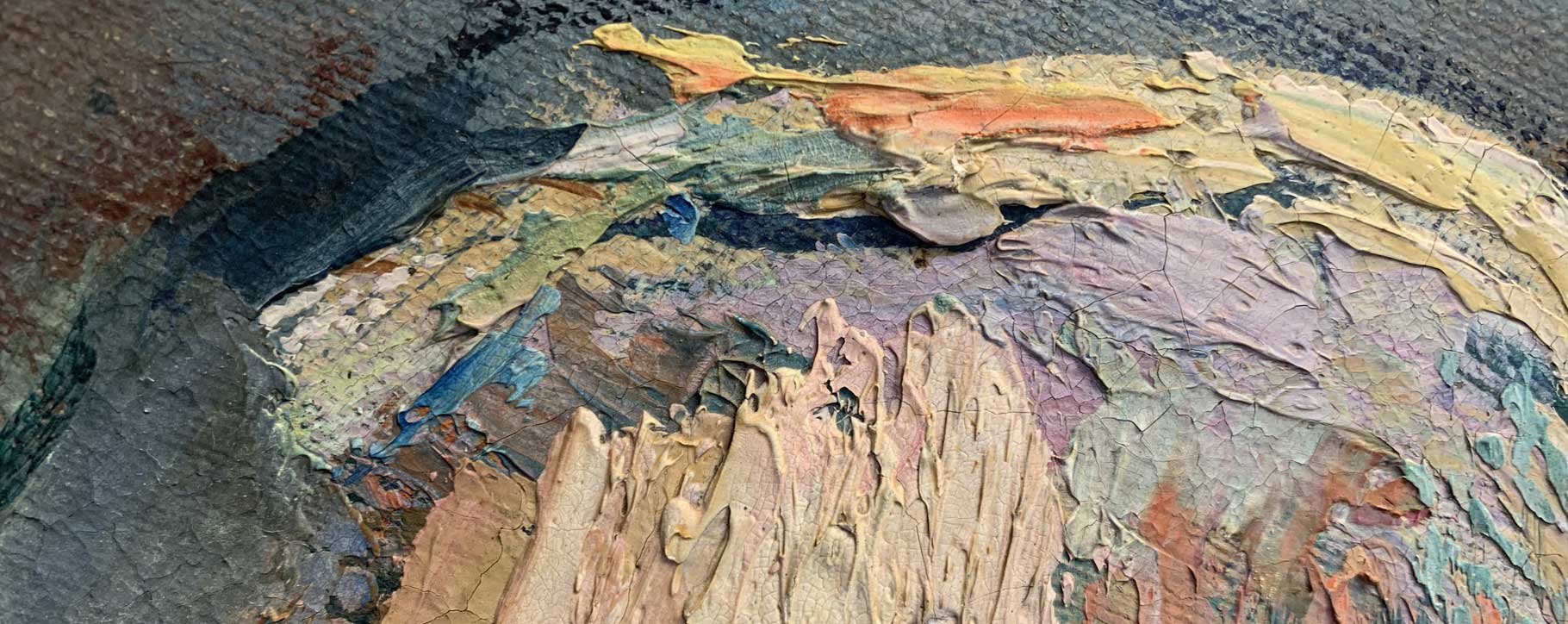 Above: a close up of an oil painting surface, a tiny fragment of this paint can be assessed under a microscope for a pigment analysis
Above: a close up of an oil painting surface, a tiny fragment of this paint can be assessed under a microscope for a pigment analysis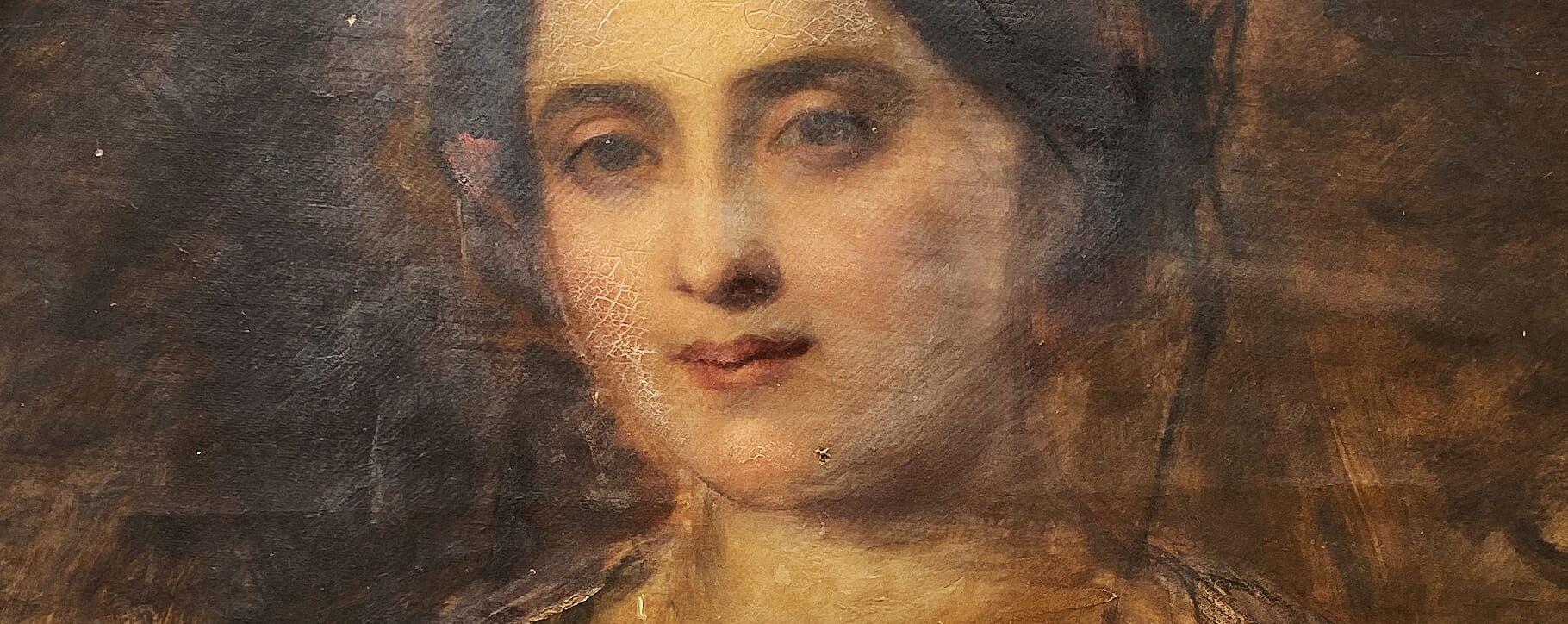 Above: a detail from a painting in our studio prior to restoration, this painting has multiple issues and requires a full assessment
Above: a detail from a painting in our studio prior to restoration, this painting has multiple issues and requires a full assessment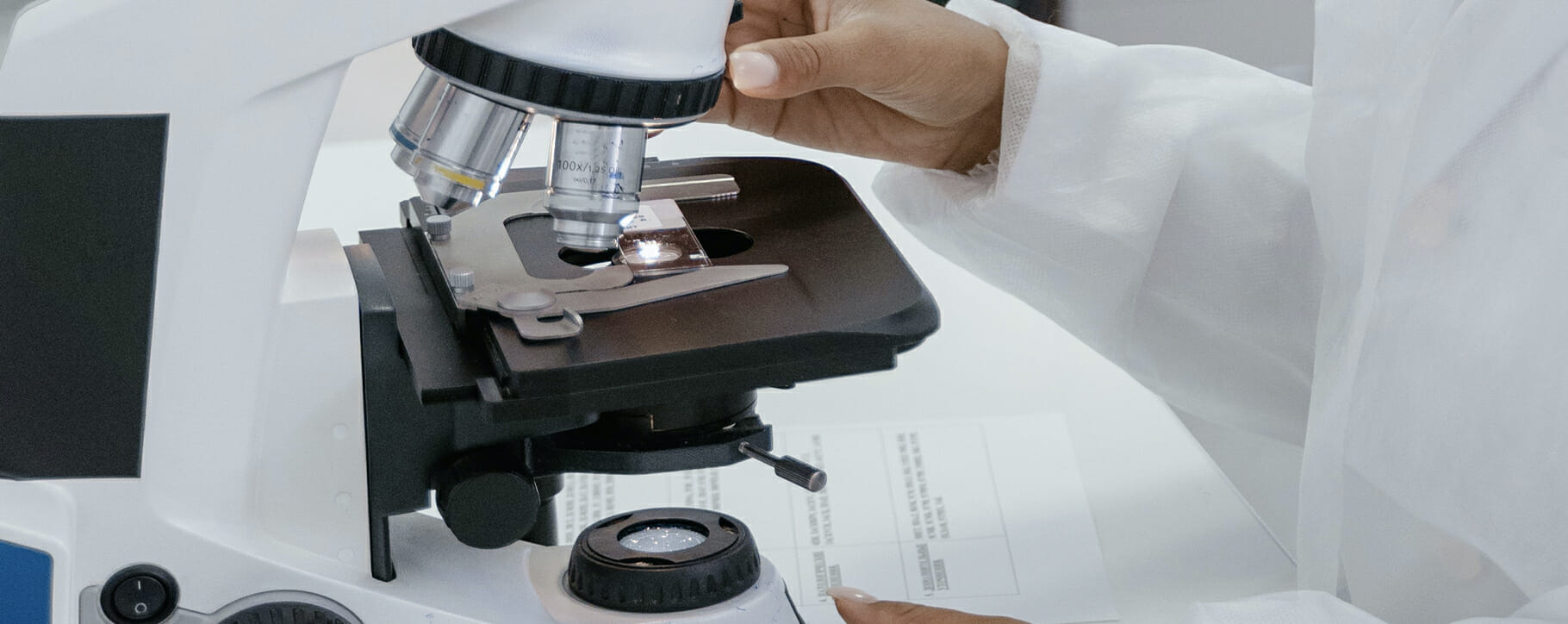 Above: pigment analysis under a microscope can be a helpful part of an overall condition report
Above: pigment analysis under a microscope can be a helpful part of an overall condition report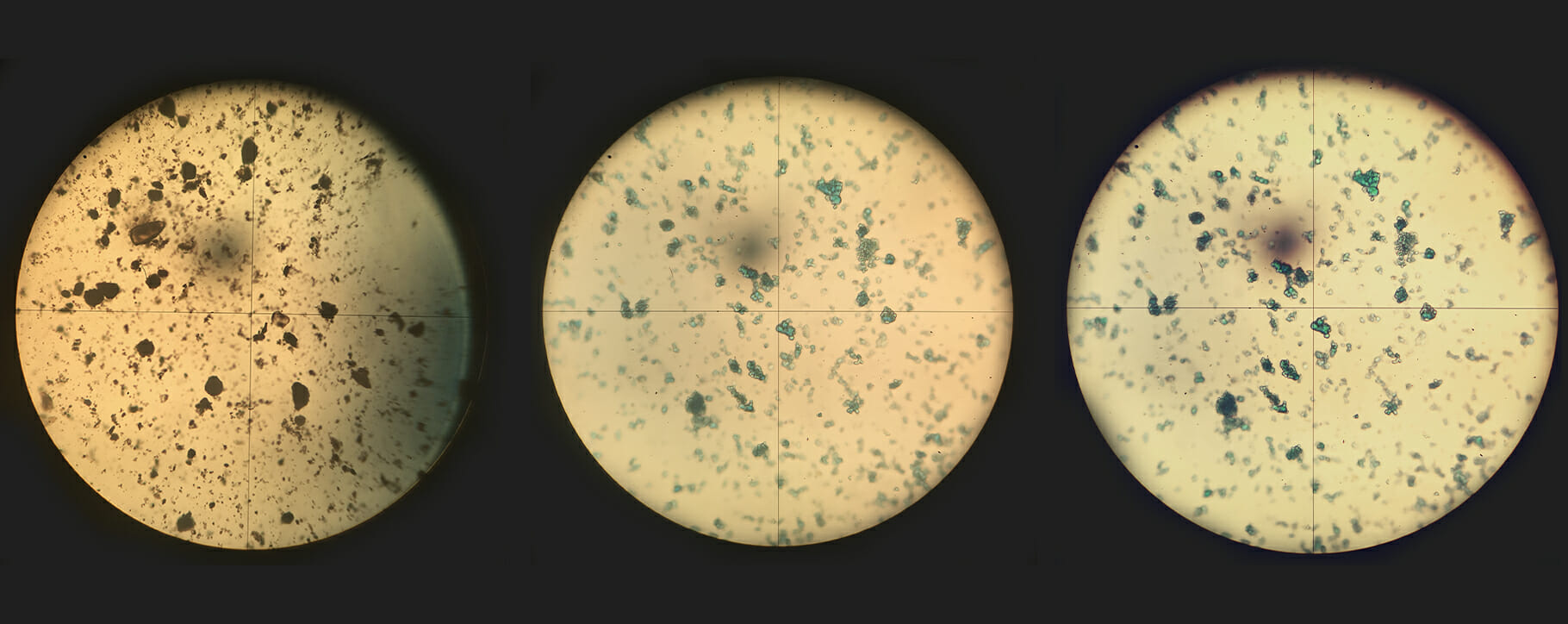 Above: pigments from various paintings put under microscopic analysis
Above: pigments from various paintings put under microscopic analysis Above: red pigments under a microscopic lens
Above: red pigments under a microscopic lens Above: pigments can be scientifically investigated with conservation techniques
Above: pigments can be scientifically investigated with conservation techniques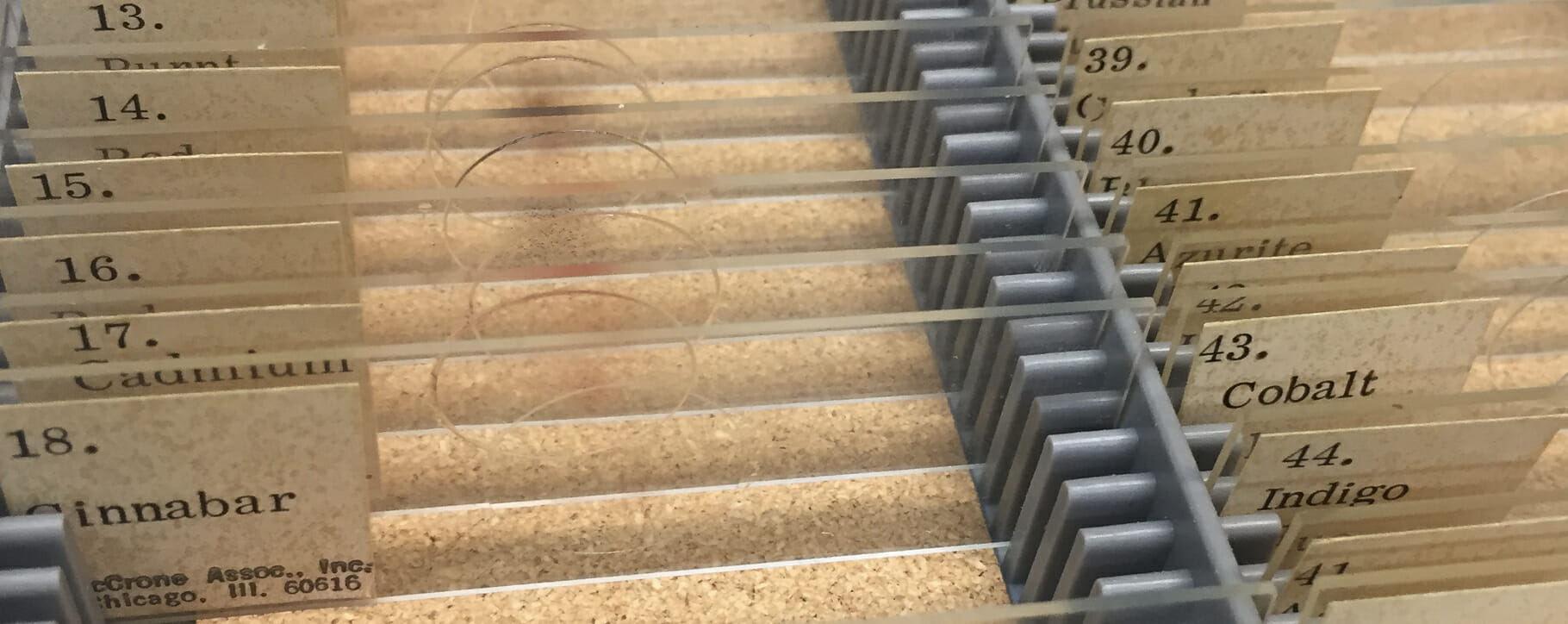 Above: pigment slides of various colours which can help to inform conservators of certain eras and mediums used in historic paint
Above: pigment slides of various colours which can help to inform conservators of certain eras and mediums used in historic paint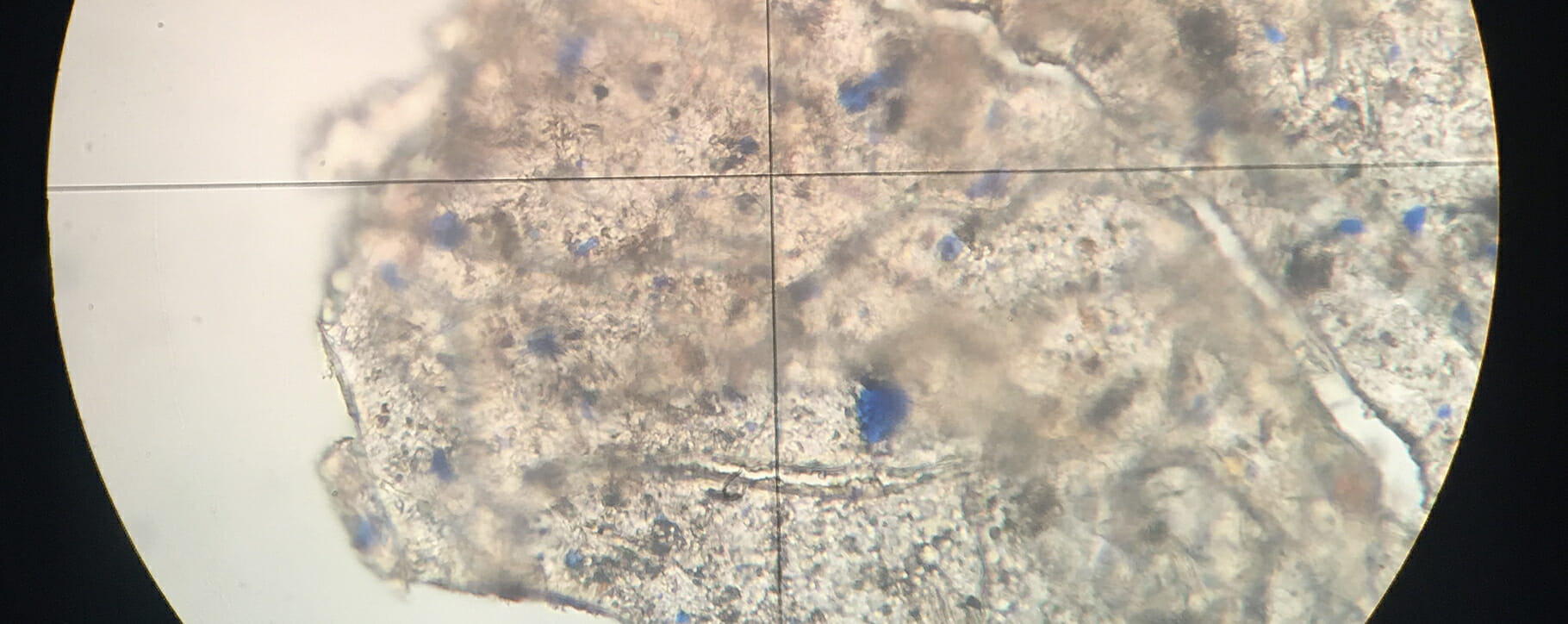 Above: a fragment from an oil painting under a microscopic lens
Above: a fragment from an oil painting under a microscopic lens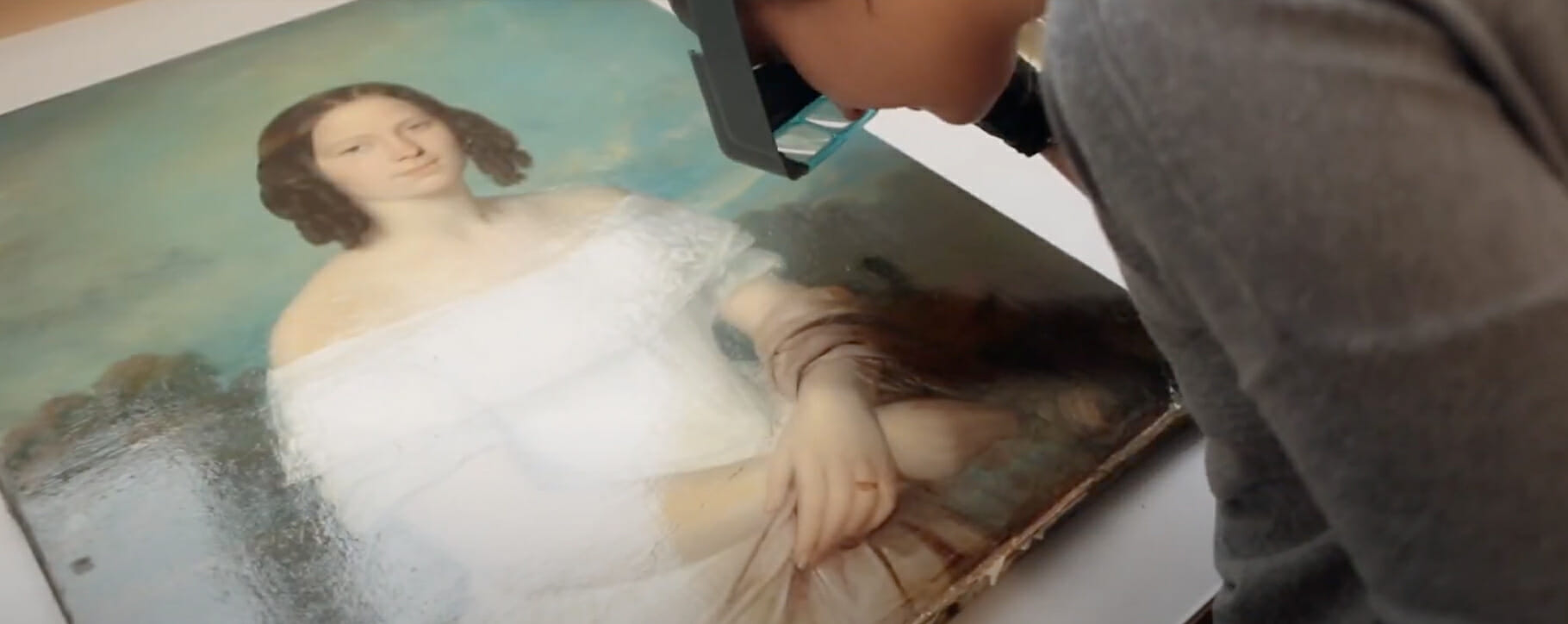 Above: our conservator looking over the surface of a painting with a magnifying lens
Above: our conservator looking over the surface of a painting with a magnifying lens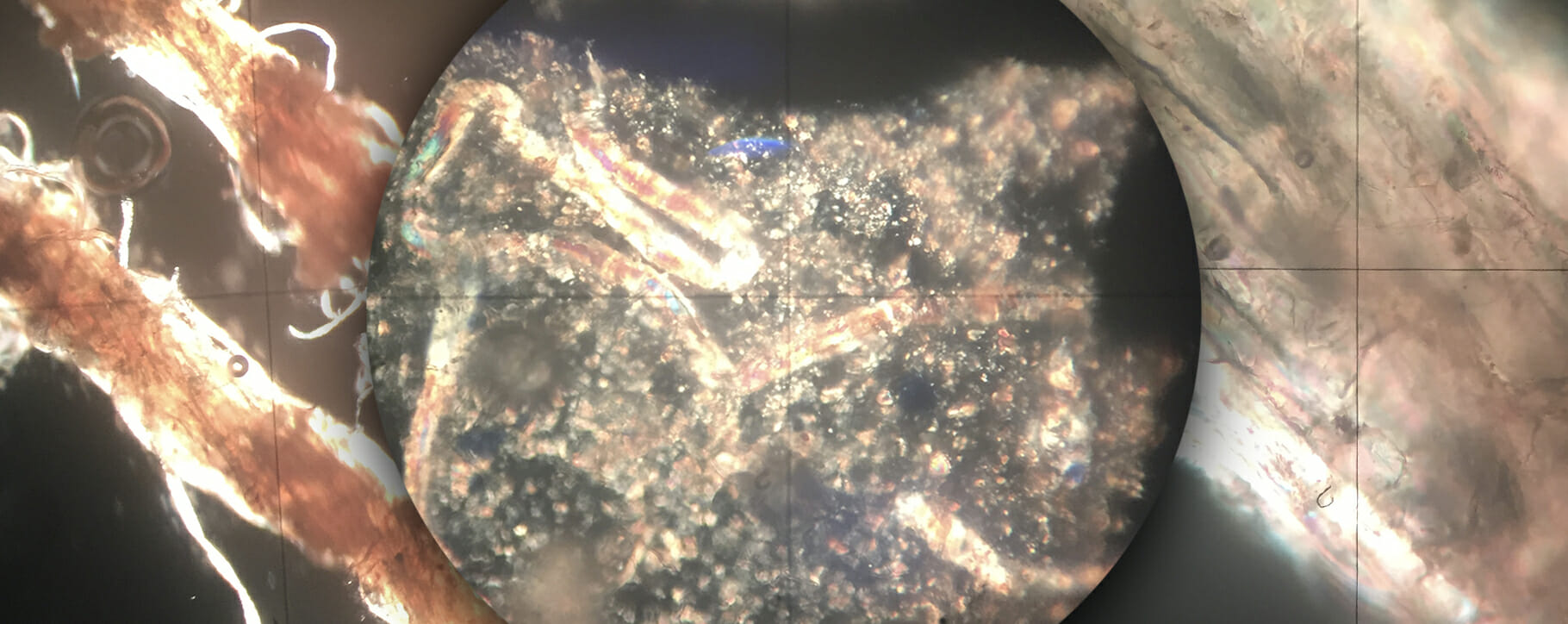 Above: a microscopic detail from a canvas fibre taken by our conservator
Above: a microscopic detail from a canvas fibre taken by our conservator Above: a fragment from an oil painting under microscope
Above: a fragment from an oil painting under microscope 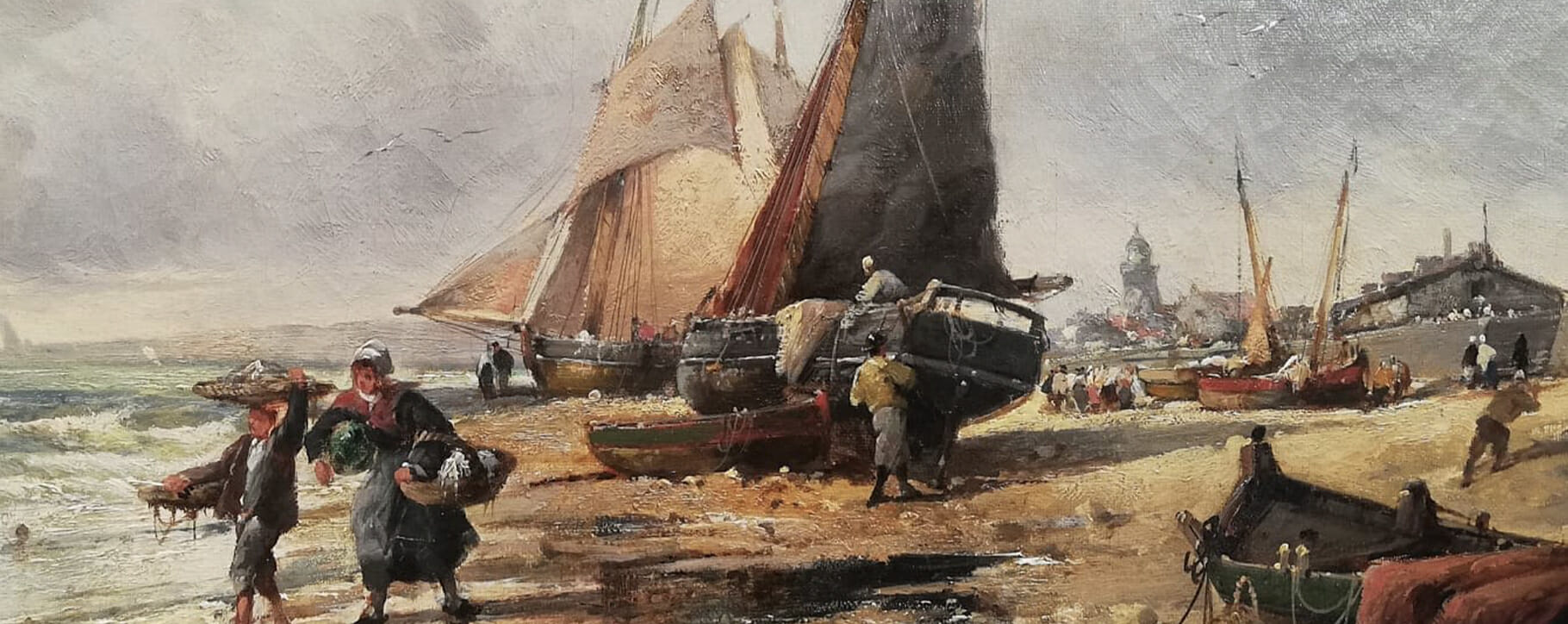 Above: a detail from a 19th century beach scene following restoration
Above: a detail from a 19th century beach scene following restoration 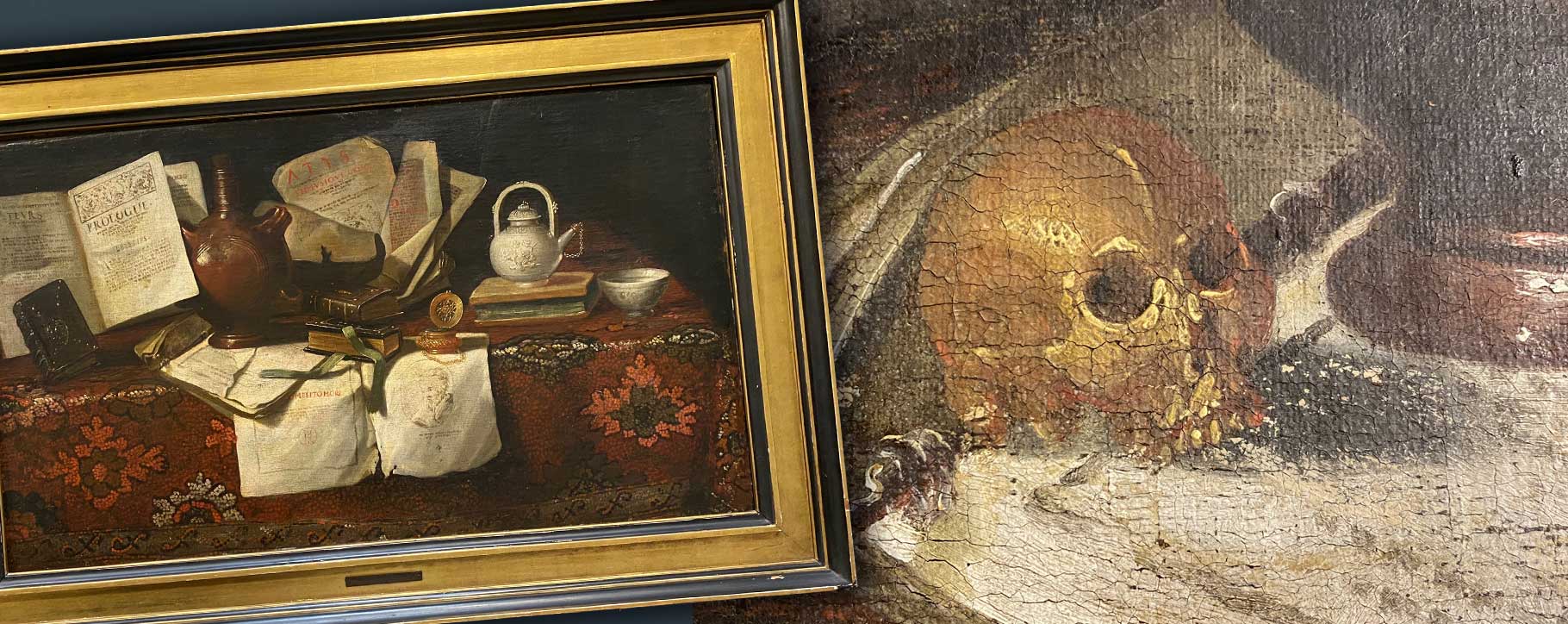 Above: a skull which had been hidden beneath a new layer on an oil painting, discovered and unveiled by our team
Above: a skull which had been hidden beneath a new layer on an oil painting, discovered and unveiled by our team Above: a lost signature which was found following investigation and restoration by our conservators
Above: a lost signature which was found following investigation and restoration by our conservators




